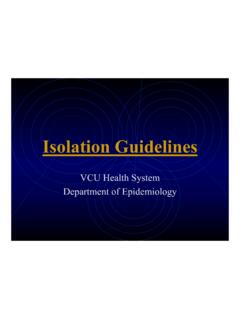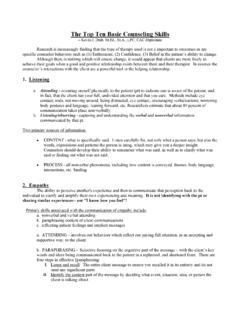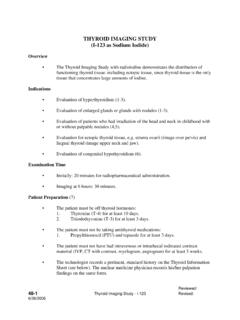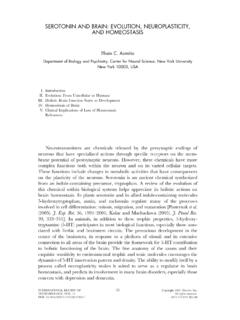Transcription of The ABC’s of ESBL for Infection Control Nurses
1 The ABC's of esbl for Infection Control Nurses : - extended - spectrum Beta- lactamases - Gonzalo Bearman MD, MPH. Assistant Professor of Internal Medicine and Public Health Divisions of Quality Health Care & Infectious Diseases Associate Hospital Epidemiologist VCU Health System ~gbearman Epidemiology Today, 30 50% of E. coli are resistant to ampicillin and amoxicillin due to a beta-lactamase ESBLs have been reported for , Klebsiella, Enterobacter, Proteus,Pseudomonas, Salmonella, Serratia Beta- lactamases : What are they ? Enzymes produced by certain bacteria that provide resistance to certain antibiotics Produced by both gram positive and gram negative bacteria Found on both chromosomes and plasmids Beta- lactamases Are primary mode of resistance to beta- lactam antibiotics Produced by some gram positive bacteria and virtually all gram negative bacteria esbl ? Resistance that is produced through the actions of beta- lactamases . extended spectrum cephalosporins, such as the third generation cephalosporins, were originally thought to be resistant to hydrolysis by beta- lactamases !
2 Not so! mid 1980's it became evident that a new type of beta- lactamase was being produced by Klebsiella & E coli that could hydrolyze the extended spectrum cephalosporins. These are collectively termed the ' extended spectrum beta- lactamases ' ( esbl 's). Mechanism of Action Hydrolysis of beta-lactam ring of basic penicillin structure Hydrolysis = adding a molecule of H2O to C-N. bond with enzyme action This opens up the ring, thus making the drug ineffective! Plasmids Rings of extrachromosomal DNA. Can be transferred between different species of bacteria conjugation Carry resistance genes Most common and effective mechanism of spreading resistance from bacteria to bacteria Bacterial Conjugation Beta-lactam Antibiotic Examples Penicillins: Penicillin, amoxicillin, ampicillin Cephalosporins: Ancef, Rocephin, Keflex, Cefotan Carbapenems: Imipenem, meropenem Beta-lactamase inhibitor Clavulanic acid + amoxicillin = Augmentin Clav. Acid + ticarcillin = Timentin Sulbactam + ampicillin = Unasyn Tazobactam + piperacillin = Zosyn Good News: Beta-lactamase inhibitors inhibit the beta lactamase thereby not allowing the molecule to hydrolyze the antibiotic.
3 Most ESBLS remain susceptible to Beta- lactamase inhibitors Bad News: some esbl producing bacteria produce large amounts of beta-lactamase thereby overwhelming the beta- lactamase inhibitors The story is more complicated . Multiple antimicrobial resistance is often a characteristic of esbl producing gram-negative bacteria. Ceftazidime Cefotaxime Ceftriaxone Aztreonam Genes encoding for ESBLs are frequently located on plasmids that also carry resistance genes for: Aminoglycosides Tetracycline TMP-SULFA. Chloramphenicol Fluoroquinolones NCCLS esbl Screening For isolates: , and : 1st step- screen using: Ceftazidime, ceftriaxone, cefotaxime, cefpodoxime, or aztreaonam 2nd Step: If MIC> 2 mcg/ml then: Ceftazidime and cefotaxime alone and in combination with clavulanate Positive test: greater than a three-fold reduction in MIC for combination versus single agent esbl status of organism is now highly likely Take home message: ESBLs are harbingers of multidrug resistance However: esbl producing organisms are still susceptible to: Cephamycins: Cefoxitin Cefotetan Carbapenems: Meropenem Imipenem Carbapenems are becoming the therapeutic option of choice What are the clinical implications?
4 Can result in treatment failure Morbidity and mortality Several outbreaks have occurred If an esbl is detected, all penicillins, cephalosporins, and aztreonam should be reported as resistant , regardless of in vitro susceptibility test results Management of esbl infections Pharmacotherapy Avoid: Ceftazidime, ceftriaxone, cefotaxime Ticarcillin/Clavulanate, Ampicillin/Sulbactam Aztreonam Fluoroquinolones, aminoglycosides, TMP/SULFA, chloramphenicol and tetracyclines Management of esbl infections Pharmacotherapy: Treatment of choice for serious infections Carbapenems Stable in the presence of most beta- lactamases Examples Imipenem Meropenem Restrict the use of 3rd generation cephalosporins. Infection Control ? As Infection Control Nurses your job is to ensure that adequate precautions are taken to minimize the risk of cross transmission! Contact precautions Cohort patients during outbreaks Promote meticulous hand hygiene practices Reminders to HCW staff about Patient esbl .
5 Status Electronic flagging of medical record Placing stickers on charts When are contact precautions discontinued? No specific guidelines: Resolution of infectious process The End!










